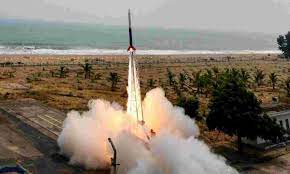Small satellites can be assembled today in less than a week at a fraction of the cost of conventional satellites.
Friday’s mission will help test the technology systems of satellite carriers. Small satellites developed by businesses, universities, private laboratories, even students, can hitch a ride on these vehicles. ISRO must hand-hold and guide such ventures
By: Editorial
Updated: November 19, 2022 6:56:28 am
On Friday, India’s space programme accomplished a landmark when the country’s first privately-developed rocket lifted off from ISRO’s launch pad in Sriharikota. Developed by the Hyderabad-based Skyroot Aerospace, the 550-kg vehicle, Vikram S, is the forerunner of the much-larger Vikram series rockets, the first of which is slated for launch next year. Friday’s mission will help test the technology systems of these satellite carriers that hold exciting possibilities. Small satellites developed by businesses, universities, private laboratories, even students, can hitch a ride on these vehicles and send back information that’s today the preserve of super speciality institutions — data on weather and earth sciences, for instance. Vikram S carries a 2.5 kg payload developed by students from India, the US, Indonesia and Singapore. The government estimates that more than 20,000 small satellites will be launched in the next decade.
According to industry data, India has more than 350 private firms in the space sector making it the fifth-largest in the world in this respect after the US, UK, Canada and Germany. But the country’s share in the global space economy is barely 3 per cent. The government intends to increase this to 10 per cent by 2030. In June 2020, it approved the participation of private players in all sectors of space activity — earlier they could only be vendors or suppliers. It also instituted the Indian National Space Promotion and Authorisation Centre, a unit of ISRO, to enable private companies to become independent players. There are early indications that these initiatives are paying off. According to this year’s Economic Survey, the country’s space regulator has received close to 40 proposals from the private sector and the academia “for activities ranging from manufacturing launch vehicles to earth observation applications”. Other private firms are close to emulating Skyroot. Agnikul Cosmos, a Chennai-based start-up, is planning the commercial launch of its rocket Agnibaan in the first quarter of next year. Last week, the company test-fired its first rocket engine — manufactured in one go, unlike conventional engines which are assembled using thousands of parts — from the Vikram Sarabhai Space Centre in Thiruvananthapuram.
Small satellites can be assembled today in less than a week at a fraction of the cost of conventional satellites. But the constraints of piggy-backing on vehicles designed for satellites weighing around 1,500 kg are beginning to show. In a good year, ISRO launches about five satellites. Compare that to the 143 satellites launched by a rocket developed by the US-firm SpaceX last year. Companies such as Skyroot and Agnikool promise cost-efficiency as well as innovation. But developing an ecosystem for private players will not be possible without the ISRO’s handholding. In the US, where private rocket ventures have a long head start over their Indian counterparts, NASA still reserves a part of its budget for such enterprises. In the coming years, the collaboration between India’s premier space research institution and private players will be keenly tracked.
© The Indian Express (P) Ltd
